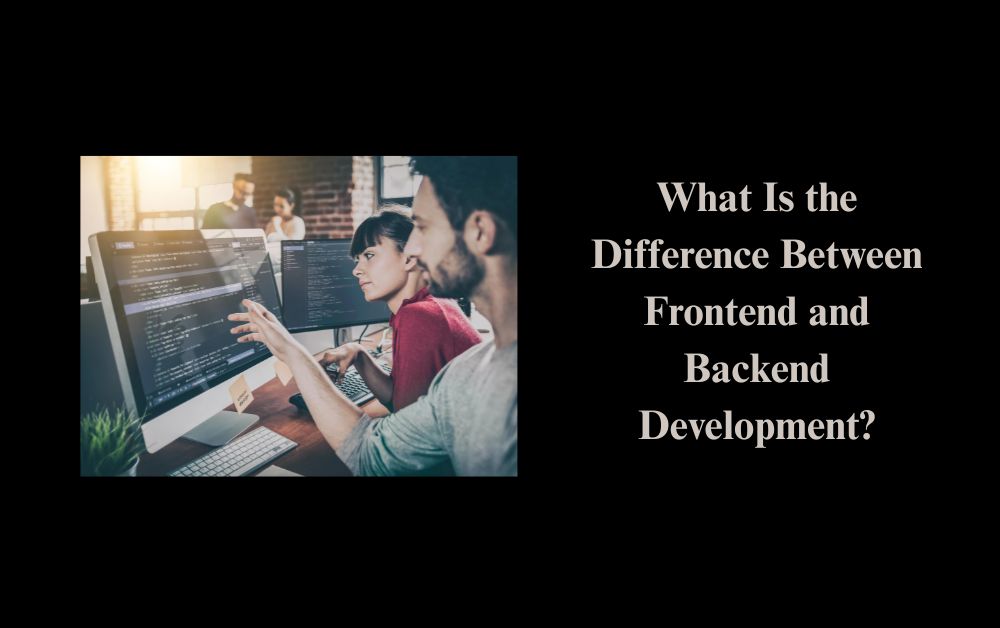If you are new to web development or just curious about how websites work, you may have heard the terms frontend and backend. These two words are very important in web development. But what do they really mean?
In this article, we will explain what frontend and backend development are, how they are different, and how they work together to build websites and web apps. We will use simple words and real-life examples so everyone can understand—even if you are not a tech expert.
What Is Frontend Development?
Frontend is What You See on a Website
Frontend development is all about what users see and interact with when they visit a website. It’s the part of the website that you can click on, scroll through, and read. If you open a webpage and see text, images, buttons, or forms—that is the frontend.
This is also called the client-side of the website because it happens on your computer or phone (the “client”).
Examples of Frontend Elements
Here are a few things that are made by frontend developers:
- Navigation menus (like Home, About Us, Contact)
- Buttons (like “Submit”, “Buy Now”)
- Images, videos, and icons
- Text, headings, and paragraphs
- Forms (like sign-up or contact forms)
- Slideshows or image galleries
- Layout and design of the page
Tools and Languages Used in Frontend Development
Frontend developers use special tools and coding languages to build what users see. Some of the most common ones are:
HTML (HyperText Markup Language)
This is the basic building block of web pages. It is used to create content like text, headings, and links.
CSS (Cascading Style Sheets)
CSS is used to style the content. It changes colors, sizes, fonts, spacing, and layout. For example, if you want a button to be blue with rounded corners, CSS makes that happen.
JavaScript
JavaScript adds interactivity to web pages. With JavaScript, you can make buttons that do something when clicked, or create pop-up messages, sliders, and more.
Frontend Frameworks and Libraries
Frontend developers also use tools like:
- React
- Vue.js
- Angular
These tools help developers build websites faster and make the code easier to manage.
Note:- Whether you need a beautiful frontend, a powerful backend, or a complete full-stack solution, we’re here to help. As a trusted software development company in Vashi, we specialize in building user-friendly, high-performing websites and apps tailored to your needs.

What Is Backend Development?
Backend Is What Happens Behind the Scenes
While frontend is everything you see, backend development is everything you don’t see. It’s the part of the website that works in the background to make everything function.
This is also called the server-side because it happens on a web server, not your computer.
The backend is responsible for things like:
- Storing user data
- Sending and receiving information
- Making sure the website works correctly
- Connecting to databases
- Securing user information
Examples of Backend Work
Here are some real examples of backend tasks:
- When you log into your email, the backend checks if your password is correct.
- When you buy something online, the backend processes your payment.
- When you fill out a form, the backend saves that information in a database.
Tools and Languages Used in Backend Development
Backend developers use different languages and tools from frontend developers. Some common ones are:
Programming Languages
- Python – Easy to read and very popular
- Java – Powerful and used in many big systems
- PHP – Commonly used with WordPress
- Ruby – Known for being simple and elegant
- Node.js (JavaScript) – JavaScript used for backend
Databases
- MySQL
- PostgreSQL
- MongoDB
These databases are where information is stored and retrieved.
Backend Frameworks
- Django (Python)
- Express.js (Node.js)
- Spring Boot (Java)
- Laravel (PHP)
These tools help backend developers build powerful systems quickly.
Key Differences Between Frontend and Backend
Let’s now look at the major differences between frontend and backend development.
The Main Purpose
- Frontend is for the look and feel of the website.
- Backend is for the functionality and logic behind the website.
Where It Runs
- Frontend code runs in the web browser (like Chrome, Firefox).
- Backend code runs on a server (a powerful computer that hosts websites).
Tools and Languages
- Frontend uses: HTML, CSS, JavaScript, React, Vue, etc.
- Backend uses: Python, Java, PHP, Node.js, Ruby, etc.
User Interaction
- Frontend interacts directly with the user.
- Backend only works when needed, like when data is saved or requested.
Examples of Work
| Task | Frontend or Backend? |
|---|---|
| Creating a login page | Frontend |
| Checking if password is correct | Backend |
| Showing user’s name after login | Frontend |
| Storing user data in a database | Backend |
| Designing a photo gallery | Frontend |
| Uploading a photo to the server | Backend |
How Frontend and Backend Work Together
They Are Like Two Parts of a Team
A website or web app is not complete without both frontend and backend. They must work together like teammates.
Here’s an example to help explain:
Let’s say you are ordering pizza online.
- The frontend shows you the menu, lets you choose your pizza, and has a button to place your order.
- The backend receives your order, saves it in the database, and sends it to the restaurant kitchen.
Without the frontend, you wouldn’t be able to place the order.
Without the backend, the order would never reach the kitchen.
How Data Moves Between Frontend and Backend
They talk to each other using something called an API (Application Programming Interface). This allows the frontend to send data to the backend, and the backend to send information back to the frontend.
For example:
- You fill out a form (Frontend).
- The form data goes to the backend via API.
- The backend checks the data and saves it.
- The backend sends a message back saying “Form submitted successfully.”
- The frontend shows a thank you message to the user.
Which One Should You Learn?
If you are thinking about becoming a web developer, you might wonder: should I learn frontend or backend?
Choose Frontend If You Like:
- Designing things
- Making websites look beautiful
- Creating user-friendly interfaces
- Working with colors, layouts, and animations
Choose Backend If You Like:
- Solving problems
- Working with data
- Building systems that do complex tasks
- Writing logic and dealing with security
Or Learn Both: Become a Full-Stack Developer
Some developers learn both frontend and backend. These people are called full-stack developers.
Being full-stack means you can build an entire web application—from the user interface to the server and database.
It takes more time to learn both, but it can open up more job opportunities.
Final Thoughts
Frontend and backend development are both important parts of building websites and web apps. They are very different but must work together to create a smooth, working experience for users.
- The frontend is what users see and interact with.
- The backend handles everything behind the scenes to make sure the website works.
Understanding the difference between these two will help you know how websites are built and what kind of developer you might want to become.
Whether you are just starting out or thinking about a career in tech, learning about frontend and backend development is a great place to begin.
For more insightful articles related to this topic, feel free to visit penwhatmatters.com








